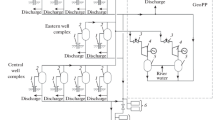Abstract—
Geothermal heat supply occupies the second place among the renewable energy sources around the world in installed capacity (70.3 GW) and in the amount of generated thermal energy (163 (TW h)/year). It is outperformed only by solar heat supply (480 GW and 395 (TW h)/year). The use of geothermal heat involves the need to drill wells and fulfill special requirements for development of geothermal fields and construction of heat-supply systems. There are deep (more than 400-m deep) and shallow geothermal heat-supply systems (GHSSs). More than 66 geothermal fields have been explored in 11 regions of Russia, and the operating reserves total more than 300 000 m3/day. The installed capacity of Russian GHSSs totals 310 MW. Differences between open- and closed-loop GHSSs are pointed out. For open-loop GHSSs, their typical process circuit arrangements implemented in Krasnodar krai and in the cities of Kizlyar and Makhachkala are presented. The GHSS process circuits with the use of heat pumps (HPs) for recovering the heat of spent geothermal water and systems operating in combination with solar units are considered. Systems that use highly mineralized geothermal heat carriers from different geological horizons with heating of sweet water, as well as GHSSs with pumpless circulation of heat carrier, are described. The article gives examples of GHSSs equipped with geothermal circulation systems (GCSs) implemented in the Khankala geothermal field in the city of Grozny, including the double GCS with the design capacity equal to 8.7 MW and the GCS in the Medvedevka settlement in the Dzhankoi raion of Crimea, a distinctive feature of which is that it uses wellhead methane for generating electricity and for additionally heating the heat carrier in the peaking modes of operation. In constructing open- and closed-loop surface GHSSs, heat pumps are commonly used. In the first case, the heat of underground or surface water bodies is used, while horizontal or vertical heat exchangers are applied in the second case. Examples of geothermal heat-supply systems are given: the surface GHSS in the city of Makhachkala, in which ground heat exchangers in combination with solar units are used, and the GHSS in the city of Krasnodar, which serves for heating an administrative building and for cooling it in summer. The key scientific–technical problems requiring further investigations and development for constructing efficient and competitive geothermal heat-supply systems in different regions of the country are formulated.











Similar content being viewed by others
REFERENCES
V. A. Butuzov, R. A. Amerkhanov, and O. V. Grigorash, “Geothermal power supply systems around the world and in Russia: State of the art and future prospects,” Therm. Eng. 65, 282–286 (2018). https://doi.org/10.1134/S0040601518050038
B. F. Mavritskii, B. A. Lokshin, and A. V. Vol’fel’d, “Forecasted reserves of thermal waters of the USSR and possible volumes of introduction of geothermal heat supply,” in Study and Use of the Earth’s Deep Heat, Collection of Papers (Nauka, Moscow, 1973), pp. 87–97 [in Russian].
A. B. Alkhasov, Renewable Power Industry (Fizmatlit, Moscow, 2010) [in Russian].
F. A. Makarenko, G. P. Gavlina, B. G. Polyak, Ya. B. Smirnov, Geothermal Map of the USSR on a Scale of 1 : 5 000 000. Explanatory Note (Nauka, Moscow, 1972) [in Russian].
E. I. Boguslavskii, Development of Thermal Energy of the Subsoil (Sputnik, Moscow, 2018) [in Russian].
A. B. Alkhasov, The Development of Low-Potential Geothermal Heat (Fizmatlit, Moscow, 2012) [in Russian].
PB-07-599-03. Rules for the Development of Thermal Energy Water Deposits (Gosgortekhnadzor Rossii, Moscow, 2003).
VSN 56-87. Geothermal Heat and Cold Supply of Residential and Public Buildings (Stroiizdat, Moscow, 1989).
B. A. Lokshin, Use of Geothermal Water for Heat Supply (Stroiizdat, Moscow, 1974) [in Russian].
A. G. Gadzhiev, Yu. I. Sultanov, P. N. Riger, A. N. Abdullaev, and A. Sh. Meilanov, Geothermal Heat Supply (Energoatomizdat, Moscow, 1984) [in Russian].
G. P. Vasil’ev, Heat and Cold Supply of Buildings and Structures Using Low-Potential Heat Energy of the Surface Layers of the Earth (Granitsa, Moscow, 2006) [in Russian].
Kh. Kh. Natanov, Preparation of Geothermal Water for Use (Stroiizdat, Moscow, 1980) [in Russian].
V. A. Butuzov and G. V. Tomarov, Geothermal Energy Supply of the Southern Region of Russia. Resources of Use, Prospects (Lambert Academic, Saar-Brücken, 2012) [in Russian].
O. A. Kremnev, V. Ya. Zhuravlenko, and A. V. Shurchkov, “On the issue of heat development of deep rocks,” in Study and Use of the Earth’s Deep Heat: Collection of Papers (Nauka, Moscow, 1973), pp. 25–34 [in Russian].
Yu. P. Morozov, Extraction of Geothermal Resources and Heat Storage in Underground Horizons (Naukova Dumka, Kyiv, 2017).
A. M. Farakhutdinov, Thermal Groundwater of the Khankal Field: Formation, Use, Forecasts, Candidate’s Dissertation in Geologomineralogy (Ufa, 2016).
Sh. M. Zaurbekov, M. M. Mintsaev, M. M. Labazanov, S. V. Cherkasov, and V. V. Butuzov, “ The results of the development of the technical design of the pilot geothermal station at the Khankal field of the Chechen Republic,” in Proc. Int. Sci.-Pract. Conf. Gtoenergo, Groznyi, June 19–21, 2015 (GGNTU, Groznyi, 2015).
M. G. Alishaev, G. M. Gaidarov, S. A. Kasparov, M. K. Kurbanov, and Yu. M. Ramazanov, “Self-circulating geothermal system,” in Proc. All-Union Conf. National Economic Methodological Problems of Geothermy, Makhachkala,1984, pp. 21–25.
O. A. Kremnev, V. Ya. Zhuravlenko, and A. V. Shurchkov, “Technical and economic assessments of geothermal heat supply systems,” in Study and Use of the Earth’s Deep Heat: Collection of Papers (Nauka, Moscow, 1973), pp. 60–68 [in Russian].
Author information
Authors and Affiliations
Corresponding author
Additional information
Translated by V. Filatov
Rights and permissions
About this article
Cite this article
Butuzov, V.A., Amerkhanov, R.A. & Grigorash, O.V. Geothermal Heat Supply in Russia. Therm. Eng. 67, 145–156 (2020). https://doi.org/10.1134/S0040601520030027
Received:
Revised:
Accepted:
Published:
Issue Date:
DOI: https://doi.org/10.1134/S0040601520030027




